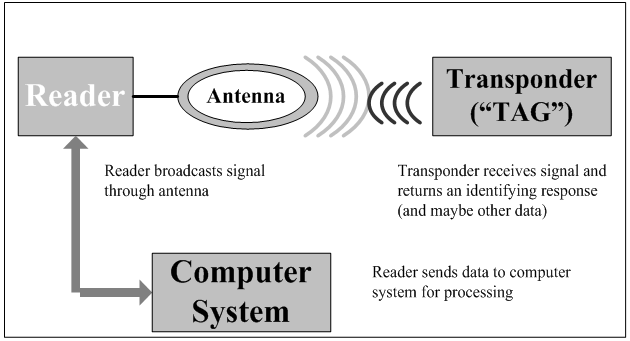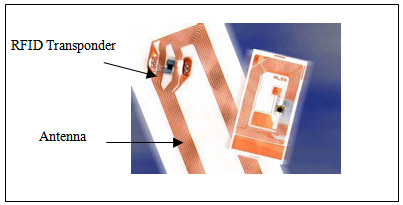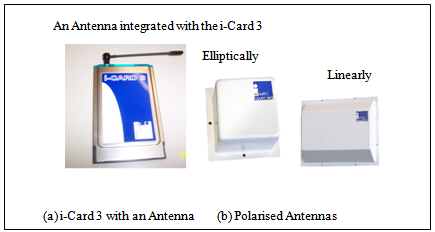-
Paper Information
- Next Paper
- Previous Paper
- Paper Submission
-
Journal Information
- About This Journal
- Editorial Board
- Current Issue
- Archive
- Author Guidelines
- Contact Us
International Journal of Construction Engineering and Management
p-ISSN: 2326-1080 e-ISSN: 2326-1102
2013; 2(4A): 7-12
doi:10.5923/s.ijcem.201309.02
RFID Technology for Materials Management in Construction Projects – A Review
Narimah Kasim1, Aryani Ahmad Latiffi1, Mohamad Syazli Fathi2
1Faculty of Technology Management & Business, Universiti Tun Hussein Onn Malaysia, Johor, 86400, Malaysia
2UTM Razak School of Engineering & Advanced Technology, Universiti Teknologi Malaysia, Kuala Lumpur, 54100, Malaysia
Correspondence to: Mohamad Syazli Fathi, UTM Razak School of Engineering & Advanced Technology, Universiti Teknologi Malaysia, Kuala Lumpur, 54100, Malaysia.
| Email: |  |
Copyright © 2012 Scientific & Academic Publishing. All Rights Reserved.
Materials management in construction projects is a key function that significantly contributes to the success of a project. The management of materials in construction projects is made problematic by materials shortages, delays in supply, price fluctuations, damage and wastage, and lack of storage space. Paper-based reports are mostly used to record and exchange information related to the materials component within a supply chain, which is problematic, error-prone, and inefficient. Generally, emerging technologies such as wireless system, bar-coding and Radio Frequency Identification (RFID) are not being adequately used to overcome human error and are not well integrated with project management systems to make the tracking and management of materials easier and faster. Thus, this study seeks to identify the potential employment of that technology focusing on RFID for materials management in construction projects. As a precursor to this work, a literature review on materials management and exploring RFID technology potentially being employ in materials tracking was conducted. In conclusion, the findings reveal the needs for more sophisticated materials management solutions to improve on-site materials tracking and inventory management processes in the future.
Keywords: Construction Projects, Materials Management, RFID, Tracking
Cite this paper: Narimah Kasim, Aryani Ahmad Latiffi, Mohamad Syazli Fathi, RFID Technology for Materials Management in Construction Projects – A Review, International Journal of Construction Engineering and Management , Vol. 2 No. A, 2013, pp. 7-12. doi: 10.5923/s.ijcem.201309.02.
Article Outline
1. Introduction
- Materials management is a vital function for improving productivity in construction projects. The management of materials should be considered at all the phases of the construction process and throughout the construction and production periods. This is because poor materials management can often affect the overall construction time, quality and budget. Reference[1] stated that it is important for planning and controlling of materials to ensure that the right quality and quantity of materials and installed equipment are appropriately specified in a timely manner, obtained at a reasonable cost, and are available when needed. The scope of the research will focus on space constraints due to the logistics in construction sites and particularly in large and complex projects. Many construction projects apply manual methods, not only for the tracking of materials, but also for materials management as a whole and this involves paper-based techniques and is problematic with many human errors. There are various advantages in the implementation of ICT in materials management, as ICT has the potential to significantly improve the management of materials on site. Reference[2] stated that, a range of opportunities for construction organisations to invest in advanced information technology and telecommunications systems. In other areas of business, such as publications, advertisement and manufacturing the growth of ICT has been very rapid. ICT applications in the construction industry are now commonplace for facilitating procurement, collaboration and knowledge management[3]. For example, product procurement has such features as direct and indirect purchasing, electronic payment, and material aggregation which can be supported by ICT. This can eliminate paper work, lower product and operational costs, and reduce cycle times. ICT is used in materials management for cost estimating through involving well known software such as Microsoft Excel[4]. However, there is not much use of modern ICT tools (e.g. wireless communications, bar-coding and RFID) to facilitate materials management processes in tracking materials quickly, accurately, and easily.In general, the current practices in tracking materials on construction projects are undertaken manually and are excessively paper-based. Previous research projects have demonstrated the successful use of automated tracking technologies such as bar-coding in helping improving materials tracking in the construction site. This includes the study of the use of bar-coding to provide instant and up-to-date information on quantities of materials exchanges between the storage keeper and the group leaders in term of the measurement of materials wastage[5]. Reference[6] have developed an automated schedule monitoring system to assist the managers to control the erection process for precast building construction by integrating bar-coding and Geographic Information System (GIS). In another study, was presented a data collection methodology that utilises both bar-coding and RFID technology to collect data (such as working hours and materials quantities) on construction sites and store the data in a central database for tracking project cost and schedule information[7]. All the above examples have shown the successful implementation of bar-coding in materials tracking processes. However, the use of the bar-coding system could involve many constraints such as it can easily be damaged, it cannot be read in direct sunlight, and it cannot withstand harsh conditions[8]. Thus, incorporate technologies such as RFID and wireless communications are expected to grow in usage to support materials management practices[9]. Recent study analyses the feasible utilisation of passive RFID technologies to automatically track the flow of structural steel components during shipping and receiving processes [10]. These technologies have been successfully used in other industry sectors such as manufacturing, retail, and transportation in improving logistics. There is potential to apply these in construction practices[3]. Therefore, the specific research is concerned with the potential employment of RFID technology in the resolution of the specific problem related to materials management on large and small construction projects.
2. Materials Management Issues
- The construction industry is the most significant industry in the economy and the successful measure with completion within time, budget, accordance with specification and satisfaction of stakeholders[11]. Construction is the process of physically erecting the project and putting construction equipment, materials, supplies, supervision, and management necessary to accomplish the work[12]. Construction projects are complex, with many organisations involved such as clients or owners, architects, engineers, contractors, suppliers and vendors. This includes the heterogeneous and often complex process of producing unique, large and immovable products with a supply of the resources (money, equipment, material, and labour). As projects grow in scale and complexity, materials management becomes more difficult, often requiring the use of appropriate tools and techniques to ensure, amongst other things, that materials are delivered on time, stock levels are well managed, the construction schedule is not compromised, and that wastage is minimised. Materials management is especially problematic for large and complex projects, where sophisticated tools and techniques are necessary. The management of materials in complex construction projects needs adequate consideration due to the various elements involved and the importance of the project. Furthermore, the implementation of appropriate Information and Communication Technologies (ICT) could facilitate new management processes for complex projects. For example, the potential of emerging technologies such as wireless technologies and tagging technologies could have a strong impact on materials management processes in the future. The improper handling and management of materials on construction sites has the potential to severely hamper project performance[13]. The result of improper handling and managing materials on site during construction process will influence the total project cost, time and the quality[14]. The costs of materials management may range from 30-80% of the total construction costs depending on the type of construction[15]. However, the total cost accounted 50-60% of construction projects is for construction materials and equipment[16]. Construction materials are major components on any project with value 50-60%[17]. Therefore, there is a need for efficient materials management in construction projects. This is because poor materials management will affect the overall construction time, quality and budget. Therefore, an effective materials management system is required in order to avoid problems, such as delays in a construction project. Many factors accelerate the delay of project duration, however poor materials management can have a major effect on site activities. Reference[18] noted that the common issues relating to materials management are: storage problems; incorrect materials delivery; subsequent design changes; materials surplus; materials damage/loss; incorrect materials take-off; and vendor evaluation. In order to overcome the problems, Reference[19] proposed real-time materials tracking process with employment of RFID in improving materials tracking and overall process of materials management on the construction site. Hence, a good materials management environment enables proper materials handling on construction projects activities.
3. RFID Technology
3.1. How RFID Works
 | Figure 1. How RFID Works (source: Wood and Alvarez, 2005) |
3.2. RFID Tags
- RFID tags can be classified into two types: passive and active. Passive RFID tags have no internal power source (they are only active when a reader is nearby to power them)[20]. Generally, passive tags have shorter read ranges of a few inches to 30 feet, but have a long life than active tags. The passive RFID tags consist of a microchip attached to an antenna and can be packaged in a different way such as mounted on a substrate to create a tag, sandwiched between an adhesive layer and a paper label to create a printable RFID label (or smart label), embedded in a plastic card, a key fob, the wall of a plastic container, and special packaging (to resist heat, cold or harsh cleaning chemicals). One example of the RFID passive tags is shown in Figure 2 where the antenna is sealed with the tags to give the tags greater read-write capabilities.
 | Figure 2. Passive RFID Tags (source: Schneider, 2003) |
 | Figure 3. Examples of Active RFID Tags (source: Identec Solutions, 2004) |
3.3. RFID Readers
- RFID readers or the interrogator typically contains a radio frequency module (transmitter and receiver), a control unit and a coupling element to the transponder[21]. According to[22], the RFID readers may be fixed or mobile and capable of communicating data to and from the tags to share data with the larger information system they support. The data is exchanged between tags and readers using radio waves. The mobile RFID readers can be integrated (fitted) into PCs, handheld computers (such as PDAs, notebook PCs, tablet PCs), or stationed and positioned at strategic points such as a facility entrance or on an assembly line[23]. The RFID readers included an antenna for sending and receiving signals to give instructions and information to the reader through the scanner. The information provided in the scanner is converted into a digital format by the reader, which the computer can then use for data analysis, recording, and reporting. Readers such as i-Card 3 and i-PORT 3, which can read 100 tags per second for the identification rate. Figure 4 shows a few examples of the RFID readers which i-Card 3 for portable RFID reader and i-PORT 3 for fixed RFID reader. Both i-Card 3 and i-PORT 3 can transmits and receives data at distances of up to 6 metres (20 ft) from an i-D tags or up to 100 metres (300 ft) from an i-Q tag. The i-Port 3 which can be used for tags identification. The portable i-Card 3 reader can provide real-time information, wherever and whenever it is needed.
 | Figure 4. RFID Readers (i-Card 3) (source: Identec Solutions, 2004) |
3.4. RFID Antenna
- An RFID antenna is the conductive element that enables the tag to send and receive data[20]. The antenna attached to a reader functions to transmit an electromagnetic field that activates a passive and active tag when it is within reading range. Figure 5 shows some other examples of the RFID tags antenna such as an antenna integrated with the i-Card 3 (Figure 5(a)) and elliptically and linearly polarised antennas (Figure 5(b)). The elliptically polarised antennas are desirable when a large quantity of tags needs to be read at one time, or when tags moving at great speeds need to be interrogated. The linearly polarised antennas are more suitable for selective data collection and restriction of read zones[24].
 | Figure 5. Examples of RFID Antennas (source: Identec Solutions, 2004) |
4. RFID Technology in Materials Management
- RFID technology has grown dramatically in usage by industries such as manufacturing, retail, distribution and etc. Nevertheless the RFID application has a short history in the construction industry. However, the construction sector in the UK has shown interest in how a number of applications such as tags can be incorporated into boilers and doors, also which can be used by most housing associations and facilities management (FM) for asset management systems [25]. Past experienced in the UK construction industry, work has been carried out into the use of RFID in quality control, logistics tracking, system or component build, waste reduction, and asset management. RFID technology is becoming cheaper and should offer construction new opportunities to improve maintenance of assets. It can provide potential savings (money and efficiency) through:• productivity improvements;• availability of ‘real time’ data capture;• job tracking;• better quality control;• better stock control;• reduction in paperwork;• reducing the incidents and associated cost of sending incorrect products to site;• improvement in customer information;• web-enabled customer information system;• improved health and safety;Reference[26] stated that the RFID systems can also provide the industry with the potential to improve construction productivity, quality, safety, and economy, cutting labour and material costs and enhancing project schedules. According to Reference[27] mentioned that the use of RFID in the construction industry such as tracking and managing unique tagged materials through the supply chain and on the construction site. They also stated that examples of RFID applications in materials management are as follow:• Inventory tracking: RFID systems can enable automatic, real-time, error-free tracking and inventory of unique materials through the supply chain from fabrication, transport, receipt, site storage, and issue to installation. For example, a pipe spool can be automatically identified as they are shipped and received and reduced error-prone in by current manually in identification, updating and immediately downloaded electronically into materials management systems without manual data entry.• Streamlined materials tracking and expediting: an RFID-enabled process can deliver material status information earlier than the current manual processes, provide field planners with reliable advance information, and be able to optimise planning on schedule critical tasks or quickly find available work for crafts that might otherwise be temporarily under-utilised.• Accurate material status and inventories: Provide accurate information about shipping, receiving, and inventory to avoid items missing, misplaces, or not received which can cause schedule disruption. This situation can easily be supported by using a hand-held reader, for example, to confirm possession of material that may have been placed or moved to an incorrect location within a yard.Many research projects have been conducted for the past few years to explore the possibility of implementing RFID technology in the construction industry. These include: • The implementation of RFID technology to monitor planning of the materials usage in a water supply project which suffers from poor materials management due to the complex operational environment[28];• The application of RFID for tool tracking on construction job sites by developing a tool tracking and inventory system capable of storing operation and maintenance data[29];• Development of an automated model for materials management and control with the application of RFID technology[30];• A model to track the progress of percentage completed in construction projects by the adoption of RFID and wireless technologies[31];• Automating the task of tracking the delivery and receipt of fabricated pipe spools in industrial projects by using RFID technology to address some problems of current methods for tracking pipe spools through automation the current tracking process[32]; • The utilisation of RFID for tracking precast concrete components and their historical information from fabrication to post construction[33]; • The development of a prototype system for identification and spatial tracking of structural steel members at the construction site[34].
5. Conclusions
- This paper has presented a review of materials management, RFID technology and employment of RFID technology in construction projects. It discussed the materials management on construction projects and potential to employ RFID in materials management practices. It clearly identified that these are important for effectively managing materials management in the construction project in order to provide better handling of construction materials to provide an overall performance of construction projects in term of time, budget (cost) and quality. The employment of RFID to support current practices of materials management in the construction site is considered improving for effective managing construction materials on site. In this paper, the emerging technologies such as RFID are discovered to be a potential for improving materials management especially for tracking of materials.
ACKNOWLEDGEMENTS
- The author would like to thank Ministry of High Education (MOHE), Office of Research, Innovation, Commercialisation and Consultancy (ORICC), UTHM, for supporting this research under the Prototype Development Research Grant Scheme (Vote No. G001).
 Abstract
Abstract Reference
Reference Full-Text PDF
Full-Text PDF Full-text HTML
Full-text HTML